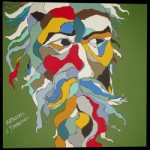 In music, the past begins with Johannes Brahms. In music, the past begins with Johannes Brahms.
Hailed in his lifetime as "the third B", a peer of Bach and Beethoven, Johannes Brahms was the last figure to enter the canon of indisputably major 19th-century composers and he was regarded as the foremost romantic composer of instrumental music in classical forms;
today, he is the most frequently played classical composer after Beethoven, and his popularity is rooted in what is now seen as a conservative musical style.
He contributed masterpieces to almost every genre.
Born in Hamburg, the son of a double-bass player and his older seamstress wife, Johannes Brahms attracted the attention of Schumann, to whom he was introduced by the violinist Joachim, and after Schumann's death he maintained a long friendship with his widow, the pianist Clara Schumann, whose advice he always valued...
He toured with the Hungarian violinist Remenyi, meeting Joachim and Franz Liszt, and then Schumann, who helped Johannes Brahms publish his piano sonatas.
Johannes Brahms eventually settled in Vienna, where to some he seemed the awaited successor to Ludwig van Beethoven.
His blend of classicism in form with a romantic harmonic idiom made him the champion of those opposed to the musical innovations of Wagner and Liszt.
In Vienna he came to occupy a position similar to that once held by Beethoven, his gruff idiosyncrasies tolerated by those who valued his genius.
Firmly based on classical foundations, his works contain hardly any programme music.
His great orchestral works are comparatively late, the first, Variations on a Theme of Haydn, appearing when he was 40.
His main works include four symphonies, two piano concertos, a violin concerto, a large amount of chamber and piano music, and many songs.
His greatest choral work is "The German Requiem" (first performed complete in 1869).
Johannes Brahms was one of the seminal musical figures of the 19th century. Opera was the only major musical medium in which he did not write.
Brahms, more than any other composer of the second half of the 19th century, was responsible for reviving what is termed "absolute" music-compositions to be accepted on their own terms as interplays of sound rather than as works that depict a scene or tell a story (program music).
Johannes Brahms was a master of the compositional craft. He often used established techniques, such as counterpoint, especially in his sets of variations, but in such novel and refreshing ways that the listener first perceives the beauty and strength of the music and only later becomes aware of the composer's technical mastery.
Johannes Brahms's love of German folk song gave his music a sturdy Teutonic character.
Although most of his music is serious, his intimate folk-song settings and his dazzling Hungarian-style finales, such as in the "G Minor Piano Quartet" or in the double concerto, reveal lighter sides of his musical personality.
His choral music includes the finest Protestant church music since that of Bach, and in his lieder (songs) he created the perfect partnership for voice and piano, although he selected many undeserving texts for them. His piano writing is more difficult than it sounds; hence, these works appeal to pianists who are more concerned with musicality than with virtuosity.
Johannes Brahms's legacy of musical craftsmanship is evident in the works of Max Reger and Paul Hindemith.
|